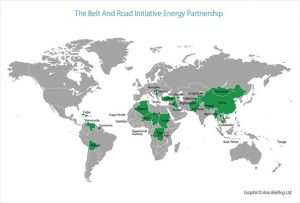The Global Energy Partnership now extends to 30 countries and concentrates on energy infrastructure development financing and construction among members
Cuba has made official its entry into the Energy Partnership of China’s Belt and Road Initiative. It originally joined the BRI in 2018.
The Energy Partnership aims to promote mutually beneficial cooperation in energy, helping countries to jointly solve problems faced by energy development, achieving common development and common prosperity, and making positive contributions to the construction of a global community with a ‘shared future for mankind’ – one of the CPC’s core directives. Washington has inevitably criticized it as being against its own interests and suggested it will lead member countries to debt and energy security issues with China.
The Belt and Road Energy Partnership was instigated in 2019 and has held two annual meetings which have established a high-quality platform for bilateral and multilateral project cooperation and technical exchanges for member states. It is designed as an international mega-platform for cooperation and exchanges under the principle of shared profit and is looking to introduce and upgrade energy supplies to many developing economies. It has a green agenda, with China offering to provide financial assistance to required projects.
Current members of the Belt & Road Initiative Energy Partnership include Afghanistan, Algeria, Azerbaijan, Bolivia, Cambodia, Cape Verde, Chad, China, East Timor, Equatorial Guinea, Gambia, Hungary, Iraq, Kuwait, Kyrgyzstan, Laos, Malta, Mongolia, Myanmar, Nepal, Niger, Pakistan, Congo (Brazzaville), Serbia, Sudan, Suriname, Tajikistan, Tonga, Turkey, and Venezuela.
Cuba’s ambassador to China, Carlos Miguel Pereira, stressed the importance of the group to expand and diversify collaboration in the energy sector and collectively overcome global challenges.
He also ratified the commitment of the Caribbean nation to contribute to sustainable progress. He invited Chinese companies and institutions and the rest of the members to work in fields such as promoting green energy and inclusive access to energy services.
Meanwhile, Cuba’s Minister of Energy and Mines, Liván Arronte, referred to the measures adopted by his government to develop renewable sources, promote the efficient use of these resources, and achieve sovereign independence in this area. He called for fostering international cooperation and solidarity in favor of developing countries, so that they can face the challenges of today’s world and meet the United Nation’s Sustainable Development Goals.
In this, Arronte criticized the impact of the United States in pursuing its economic, commercial, and financial blockade of Cuba, still considered the main obstacle for the development of Cuba and impacting negatively on the Caribbean region. Cuba should be a Caribbean growth driver; it has the largest regional economy and population. US sanctions against it stem back to the origins of the Castro regime and have been in place for over 60 years. Caribbean regional development has suffered as a result.
Déborah Rivas, Cuba’s deputy minister of Foreign Trade and Foreign Investment, stressed that Cuba had become one of few Latin American countries to join the Energy Partnership. The country has also recently become an Observer Nation to the Eurasian Economic Union, (EAEU) which includes Armenia, Belarus, Kazakhstan, Kyrgyzstan and Russia, with the latter investing in Cuban railway infrastructure and rolling stock. A Free Trade Agreement with the EAEU is a logical next step.
The “Belt and Road Energy Partnership” (BREP) was launched in October 2018 during the Belt and Road Energy Ministerial Conference in Suzhou and was officially inaugurated in Beijing in April 2019. It now has 29 member countries in addition to China.
This article was retrieved from:
(3 November 2021, 08.40 AM Jakarta Time).

